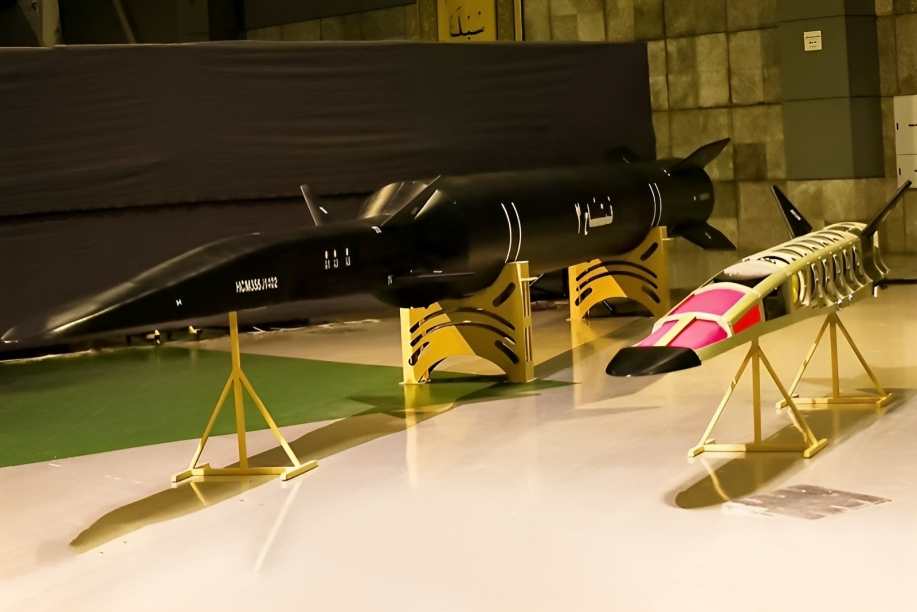Iran’s Islamic Revolution Guards Corps (IRGC) unveiled the new ballistic missile “Fattah 2” equipped with a hypersonic glide vehicle (HGV) warhead.
The sophisticated, homegrown missile was displayed during a visit by Iran’s Supreme Leader Ayatollah Ali Khamenei, who also serves as the Commander-in-Chief of the Iranian Armed Forces, in Tehran on November 19, according to the Tasnim News Agency.
The weapon was revealed at an exhibition showcasing the achievements of the IRGC Aerospace Force held at Ashura Aerospace Science and Technology University. The exhibition featured various homegrown military products, including missiles and drones.
The fully indigenous missile is equipped with a hypersonic glide vehicle (HGV) warhead, capable of maneuvering at hypersonic speeds ranging between 5 to 20 Machs, equal to about 6,100 and 24,000 kilometers per hour, depending on its design and utility. An HGV warhead allows the ballistic missile to significantly alter its trajectory after launch.
Conventional ballistic missiles follow a predictable ballistic trajectory and are vulnerable to air defense systems. The in-flight maneuverability of HGVs makes them unpredictable, enabling them to effectively evade air defenses.
The first version of the Fattah ballistic missile, with a range of 1,400 kilometers, was unveiled in June. The precision-guided missile features a two-stage solid fuel engine with a maximum speed of Mach 15 (18,522 km/hour) on impact. The missile can bypass and destroy air defense systems, and it possesses excellent maneuverability and stealth ability to pass through radar systems.
Fattah includes a movable secondary nozzle and uses solid propellants, allowing it to reach high speeds and “perform various maneuvers inside and outside the earth's atmosphere.”
During the exhibition, the IRGC also showcased an advanced version of the Shahed-136 strike drones, named Shahed-238, equipped with a jet engine and improved guidance systems. The jet-powered drone comes in three variants with different guidance systems. The standard model features an autonomous guidance system with GPS integration. The second version has an infrared/optical guidance system, enabling its use against heat-contrast targets such as military equipment. Another variant is believed to possess a radar guidance system, allowing it to target radar installations based on their electromagnetic emissions and potentially disrupt enemy air defense networks.
Experts note that the drones are painted an unusual black color, possibly related to the use of radio-absorbing materials. The technical specifications of the Shahed-238 remain undisclosed, with analysts suggesting that the jet engine could provide the UAV with high speed but might reduce its flight range.
In recent years, Iranian military experts and technicians have achieved self-sufficiency in domestically producing a wide array of equipment, making significant strides in the realm of weaponry. The IRGC’s Aerospace Department is credited with developing the new missile and the bulk of Iran's missile program.
Iranian officials consistently assert that their missile program is for deterrence, emphasizing their commitment to enhancing military capabilities, including missile and drone technology, despite Western sanctions and opposition from Israel.







 President Ilham Aliyev shed light on the evolving contours of the peace process with Armenia during an international conference in Baku this week. ...
President Ilham Aliyev shed light on the evolving contours of the peace process with Armenia during an international conference in Baku this week. ...
 Azerbaijan and Armenia started the process of demarcation of their border on Tuesday, with the installation of the first border markers based on ge...
Azerbaijan and Armenia started the process of demarcation of their border on Tuesday, with the installation of the first border markers based on ge...
 President Aliyev emphasized the critical role of the North-South Transport Corridor in fostering transport cooperation between Azerbaijan and Russi...
President Aliyev emphasized the critical role of the North-South Transport Corridor in fostering transport cooperation between Azerbaijan and Russi...
 Iran and Pakistan have signed eight cooperation documents in various fields, and agreed to strengthen ties to fight terrorism in the region.
Iran and Pakistan have signed eight cooperation documents in various fields, and agreed to strengthen ties to fight terrorism in the region.
 As the conflict between Ukraine and Russia escalates, the strategic importance of Kharkiv, Ukraine's second-largest city, has come sharply into focus.
As the conflict between Ukraine and Russia escalates, the strategic importance of Kharkiv, Ukraine's second-largest city, has come sharply into focus.



